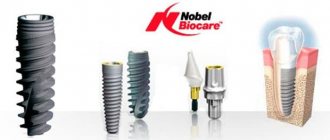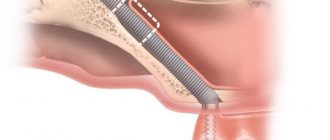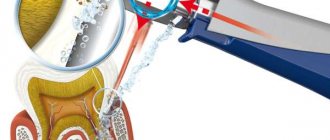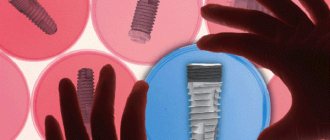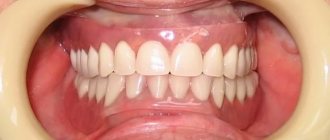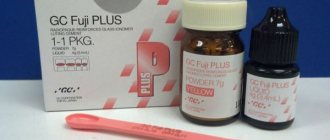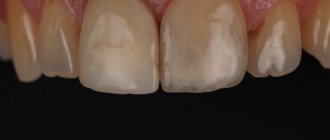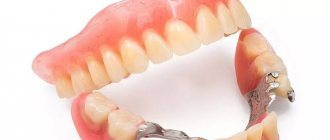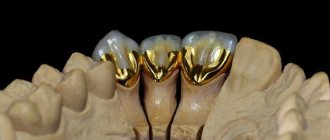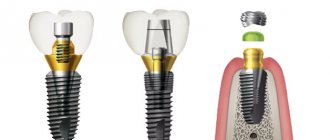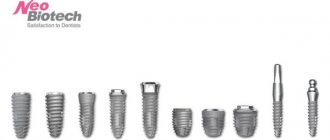2289
To restore the aesthetics and functionality of dental elements, many technologies have been developed, but many of them are not reliable enough or have a decent number of contraindications.
The unique Nobel Procera technology was developed taking into account all the disadvantages of alternative production.
The speed of installation, biocompatibility, and reliability of use of systems created using modern technology make it possible to restore chewing functions even in hopeless patients.
General overview
Nobel Procera technology is a metal-free restoration of the dentition. Modern methods for manufacturing prosthetic products make it possible to produce reliable and high-precision products, taking into account all the individual characteristics of the patient and in compliance with dental standards.
The technology makes it possible to produce fixed dentures in the complete absence of dentition according to the “All on Four” scheme with the introduction of an implant, or veneers, crowns, bridges for the restoration of one or several elements.
The main point of the technology is to use frames that are made using the method of milling block blanks under ultra-precise conditions of the manufacturing plant, using a three-dimensional computer modeling system.
This helps to achieve the best aesthetic and functional results in the manufacture of structures of any configuration.
Implantation Nobel
Nobel implants vary in purpose and design characteristics. Each type of rod has an individual shape, thread and connection type. The manufacturer has developed pins that solve a specific problem depending on the structural features of the jaw bones or the complexity of the clinical case. To date, Nobel models are represented by several series of implants. A wide range allows the doctor to choose the right type of implant system for the patient to restore teeth with maximum preservation of soft tissue.
Active
Designed for osseointegration in cases of severe bone tissue deficiency. The special shape of the pin provides a reliable basis for prosthetics of chewing and anterior teeth. Ideal for immediate implantation. Due to the high survival rate, the Active implant can be immediately fitted with dentures or crowns. A high-quality product from Nobel guarantees high aesthetics of the soft tissues around the neck of the artificial tooth.
Replace
The system includes several types of implants that follow the shape of the tooth root. The rods taper downwards and are easily screwed into the bone tissue. Small indentations in the neck area create an attractive soft tissue contour. This indicator is of great importance when replacing anterior row prosthetics. With Replace models, emergency implantation with immediate loading can be performed.
Branemark
The line was developed using innovative technologies and is positioned by the manufacturer as the most advanced system in the world. This is a thoroughly researched series that has been tested in various clinical trials. A wide variety of abutments makes it possible to install prostheses using Branemark implants in the most complex cases.
Parallel CC
A universal rod that is suitable for implantation into any type of bone tissue. A slightly offset neck provides sufficient volume of soft tissue surrounding the implant, which allows for high gingival aesthetics. The products are installed vertically and parallel to each other. Great for all-on-4 or all-on-6 protocols.
Speedy Groovy
The system was specially developed by the manufacturer for implantation using the all-on-4 protocol. The technique itself, intended for prosthetics of the entire jaw (upper or lower), was also proposed by Nobel.
Trefoil
The system is intended for the installation of dentures using three implants with complete edentia. The rods are connected to each other by a special arc, which is secured with screws and washers. The model is used only for the lower jaw.
Zygoma
The model has an elongated shape, making it possible to install it in the cheekbone.
Dentists offer Zygoma implants for patients who are missing a large number of teeth in the upper jaw, as well as severely weakened bone tissue. Rods are used when using all-on-4 or all-on-6 protocols. Collapse
Peculiarities
Prostheses using this technology are made without the use of metal. The main materials are zirconium dioxide and aluminum. Modern elements are very durable, their service life is more than 20 years. In this case, the thickness of the finished structure does not exceed 0.4 mm.
Such systems are resistant to loads and deformation; they are even fixed to implants.
Zirconium dioxide structures allow achieving high aesthetic results, do not damage the gingival margin and do not cause an allergic reaction.
Due to the high strength of the materials that are necessary to create a prosthesis, it is impossible to form them manually. For this purpose, a CAD/CAM system is used.
It includes three stages:
- oral cavity scanning;
- virtual creation of a prosthesis;
- fabrication of the structure.
The use of x-rays allows you to obtain images in one plane, while computer scanning creates an accurate model of the tooth, taking into account the upper and lower rows.
The results obtained are processed by a computer program, and a virtual prosthesis is created, which is used to reproduce an exact copy using robotic equipment.
Production stages
The first stage is the process of tooth preparation by a doctor to install zirconium crowns. Next, impressions are made of both jaws, at the same stage the shade of the tooth enamel is determined to achieve the identity of the prosthesis.
Impressions are necessary to create an analogue that accurately copies all of the patient’s teeth. They are placed in a device that replicates the function of the temporomandibular joint. The device allows you to achieve optimal aesthetics and design comfort for the patient.
After this, the tooth in need of restoration is identified from the general model. His model is mounted in a Nobel Procera Scanner laser installation, where scanning and creation of a three-dimensional projection takes place.
The specialist makes a computer simulation of a zirconium dioxide cap, which will serve as a frame for the future crown. Digital data in electronic form is given to the manufacturing plant in Sweden for production.
The milling unit consists of a computer-controlled machine and two tips with replaceable cutters, which are directed mutually perpendicularly. Their movement polishes the product and removes excess material.
The finished frame is delivered back to the clinic, where specialists coat it with a specific ceramic mass to improve its aesthetic properties.
Methods of dental prosthetics without grinding and indications for their use.
Come here if you are interested in which crowns for implants are better.
At this address https://www.vash-dentist.ru/protezirovanie/nesemnyie-p/molochnyih.html we will tell you in what cases prosthetics of children's teeth is justified.
Beam structure Nobel Procera
Nobel Procera is a modern Swiss design for conditionally removable prosthetics. Just because a denture is removable does not mean it needs to be removed constantly. It is enough to do this once every 1-2 weeks for cleaning and care. Thanks to the convenient ergonomic locking fastening, you can remove and install the beam yourself.
A bridge prosthesis supported by implants has an extremely high precision of fit and evenly distributes the chewing load, eliminates disorders of the speech apparatus, and does not cause physical and moral discomfort.
Advantages
Nobel Procera technology has a number of advantages:
- Maximum adherence to the edge without damaging the gums, thanks to the use of computer modeling.
- Lightweight and durable metal-free system.
- Hypoallergenic, biocompatible, gum color fastness.
- Resistant to temperature and chemicals.
- Aesthetics of the product. It is almost impossible to distinguish a prosthesis from a natural tooth.
- Maximum preservation of dental tissue during grinding.
- Minimum load on the tooth.
Features and advantages of beam prosthetics
Bar prosthetics is a relatively new step in orthopedics. The technology allows you to fasten the beam structure firmly and reliably. The technique practically does not limit the list of permitted foods, and special locks allow you to remove the prosthesis for cleaning and install it yourself afterwards.
Indications for beam prosthetics:
- Loss of several teeth in a row or an entire row of teeth.
- Atrophy of bone tissue, which does not allow implantation of all teeth.
Contraindications to beam prosthetics are similar to contraindications to implantation, since although the technique is minimally invasive, it still requires the installation of a minimum number of artificial roots on which the beam will be attached.
Advantages of beam prosthetics:
- High comfort during operation. You can sleep in a prosthesis; it does not cause any discomfort.
- The chewing load is uniform on the muscles, joints and jawbone, thereby reducing the risk of bone tissue atrophy.
- The design is suitable both for the loss of several teeth in a row, and for the loss of the entire dentition.
- Easy maintenance, ability to remove and install the structure yourself.
- Highly aesthetic and natural: even at close range, the prosthesis cannot be distinguished from ordinary teeth.
- The hypoallergenic alloy of the metal beam does not cause rejection and oxidation.
- Long service life (about 7-8 years).
This type of prosthetics is suitable if the patient’s bone tissue without bone grafting does not allow the implantation of all lost teeth. So, for a prosthesis for 5-7 teeth, it is enough to install only 3-4 implants on which the structure will be attached.
Main differences from conventional crowns
The main difference between Nobel Procera technology and conventional crowns is the absence of metal, which allows you to achieve a 100% natural appearance of the dentition.
The dullness of a regular tooth is achieved due to the presence of enamel and dentin, the transparency of which is not the same. The light refraction in Nobel Procera systems is similar, only instead of natural dental tissue there are two other layers - ceramic enamel and a zirconium dioxide base.
The presence of metal in such structures reduces the reliability of the prosthesis and does not ensure a complete fit to the edge of the gum.
Nobel Parallel Conical Connection Implant System
Implants are universally used; they are used in most clinical cases, regardless of how many teeth need to be replaced. Nobel Parallel CC implants have parallel walls and a cone-shaped apical part, which provides a high level of primary stabilization in bone of any density. The abutment-implant connection is an internal cone with an anti-rotation hexagon.
Contraindications
Contraindications to such prosthetics are pregnancy, acute chronic diseases of the body, bleeding disorders, undergoing radiation therapy, and drug use.
Relative contraindications include inflammation of the oral mucosa and the presence of dental problems, after which, after elimination, such prosthetics can be performed.
What are metal-plastic crowns, their advantages and disadvantages.
This publication contains all the most important things about CBW prosthetics.
Here https://www.vash-dentist.ru/protezirovanie/nesemnyie-p/koronki-np/tselnolityie.html we offer a detailed description of a one-piece crown.
Price
Pricing for prosthetics using Nobel Procera technology varies significantly. This depends on many factors such as:
- Prestige of the clinic.
- Geolocalization of the institution.
- Doctor's professionalism.
- The need for additional manipulations.
The cost of a temporary prosthesis is 6,000 rubles; if it is needed urgently, the price rises to 9,600 rubles, and installation of a permanent structure, taking into account a doctor’s appointment, making impressions and delivery from the factory, can reach 122,000 rubles.
If it is necessary to install one or more implants, the price for installing one unit is 12,000 rubles, and if it is produced by Nobel Biocare - 35,000 rubles.
The video provides additional material on the topic of the article.
Warranty
The use of NobelProcera technology in the production of metal-free orthopedic structures provides high quality and patient comfort when talking, chewing, etc., and minimizes the risk of dental diseases. Dentures and crowns made using this technique provide a flawless smile and self-confidence. If any non-temporary NobelProcera product is damaged, you are guaranteed a free replacement for a period of five (5) years from the date of installation in your mouth. Also, at Ikar dental clinics, you will be provided with free replacement of NobelProcera or Nobel Biocare orthopedic design elements, if this becomes necessary when replacing a damaged NobelProcera product.
Reviews
A healthy smile is the key to success, which is why thousands of people use Nobel Procera technology to restore it.
If you have experience using such structures, we ask you to leave your comments in which you can share your impressions and results of prosthetics.
If you find an error, please select a piece of text and press Ctrl+Enter.
Tags dental crowns fixed dentures
Did you like the article? stay tuned
Previous article
Correction of a gummy smile using gingivectomy
Next article
Let's be honest about the perfection of removable silicone dentures
